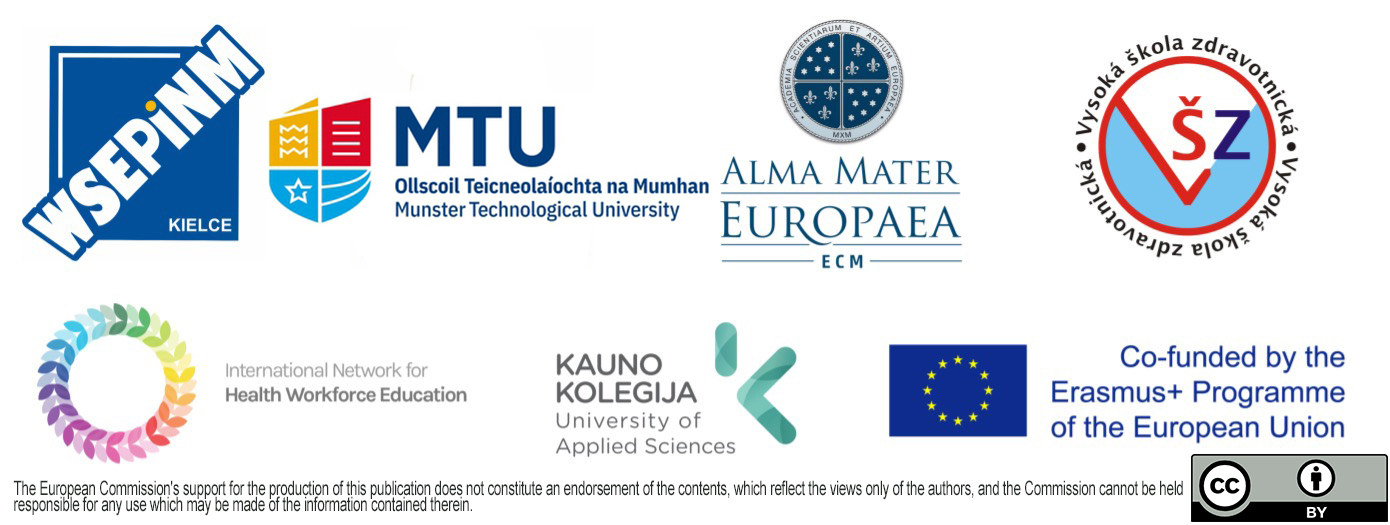The Guide
A handbook for teachers, also useful for students, especially those who want to study independently.
1. Introduction

What is the purpose of this publication?
This handbook is for the tutor of the course based on the online materials found at https://moodle.safemedic.eu . The materials were developed as part of the SAFEMEDIC project, financed by EU Erasmus + program, in 2019-2021. The project was coordinated by Lipinski University in Kielce, Poland and the partners were five universities from Ireland, the Czech Republic, Lithuania, Slovenia, and the international organization International Network for Health Workforce Education (INHWE).
The aim of the online materials (video
lectures, coursebooks, instructional videos) and the workshops is to improve
the understanding of the broad context of aggression in the healthcare sector
and to develop the ability to deal with aggressive patient behaviour. The whole
course can be tailored to different learning contexts, as needed. The
publication includes guidance to support the delivery of workshops, both
in-class and online.
The selection and order of presentation of topics should be adjusted to the needs of specific groups of participants by the tutor/moderator delivering a course. There’s no need to run all modules or to run them in the exact order suggested in this resource.
The practical part – module 3“Negotiations” and module 4 " Special Coercive measures: techniques of de-escalating aggression in patients in hospital setting” –should be practiced in direct contact, in practical classes, after the participants have familiarized themselves with the video materials.
Who is this publication for?
These materials are intended for academics and trainers in the safety of healthcare professionals who are in contact with patients. A flexible approach is recommended: the course can be integrated into existing curricula or proposed as a stand-alone training course. Although the material is intended for the higher education sector, it will also be useful for those training active healthcare staff. From the geographical point of view, the immediate context of the resource is the health sector in the project partner countries, however, thanks to the transnational approach and nature of the issues presented, these materials are easily adaptable to the needs of educators from other countries.
Who will benefit from this publication?
The key beneficiaries of the "SAFEMEDIC" project are students of medical faculties, especially of nursing and emergency medical services, as well as professionally active healthcare staff. This publication is intended to help the course tutor to choose from the numerous online materials those which are useful for their group of students and to conduct a course that uses blended learning (online classroom and individual work) or which is exclusively online. In the case of blended learning, it is recommended to use the flipped classroom method, where students come to class after having studied the previously assigned online material.
The last two modules - practical training - require contact training.
Pedagogical approach
"Knowledge is created by learners"
Kolb’s approach to learning through experience underpins the module design. According to the Kolb Cycle the learning process repeats a cycle of four steps: experience, reflection, generalization, and application.
The education of paramedics and nurses is naturally based on learning through experience in our subject matter - through experiencing increasingly difficult situations while developing knowledge and skills.
All the proposed activities for use in the classroom aim to establish a connection between the presented topic and the course participants’ past, present, and future work experiences so that, in accordance with the principles of Human Centred Design, they are offered an engaging and meaningful training.
To supplement the experiential, practical learning with theoretical background, the SAFEMEDIC materials include lectures that range from the anthropological, psychological and legal approach to the issue of aggression and violence as well as detailed practical modules.
Notes for the tutor
Each workshop includes tutor notes based on the content of the online modules. Each session is expected to last approximately two teaching hours. Sessions can be extended or shortened according to the choice of materials and topics.
Equipment and materials
The equipment and materials needed to run each workshop are readily available in the higher education sector. These include: a room suitable for interactive group work, projector, screen, computer / laptop, internet access, speakers, flip chart, pens, etc. Any additional resources needed for individual workshops are listed in the notes for the tutor.
Course content
The learning content of the course is organized into the following modules:
· Introductory section
· Module 1-1: Violence and aggression - anthropological perspective
· Module 1-2: Violence and aggression - psychological perspective
· Module 2-1: Violence and aggressive behaviour - legal perspective
· Module 2-2: Risk management
· Module 3: Negotiations
· Module 4: Techniques of de-escalating aggression in patients in a hospital setting
SAFEMEDIC
Log in to https://moodle.safemedic.eu
After logging on to the website https://moodle.safemedic.eu you will find yourself in the "cockpit" of five SAFEMEDIC courses, where you choose the language version of the course. The following versions are available: English, Czech, Lithuanian, Polish, Slovenian, Italian, which reflects the international composition of the team that prepared this project.
This Guide is for the English version.
You can use the course materials sequentially or selectively, depending on your needs.
